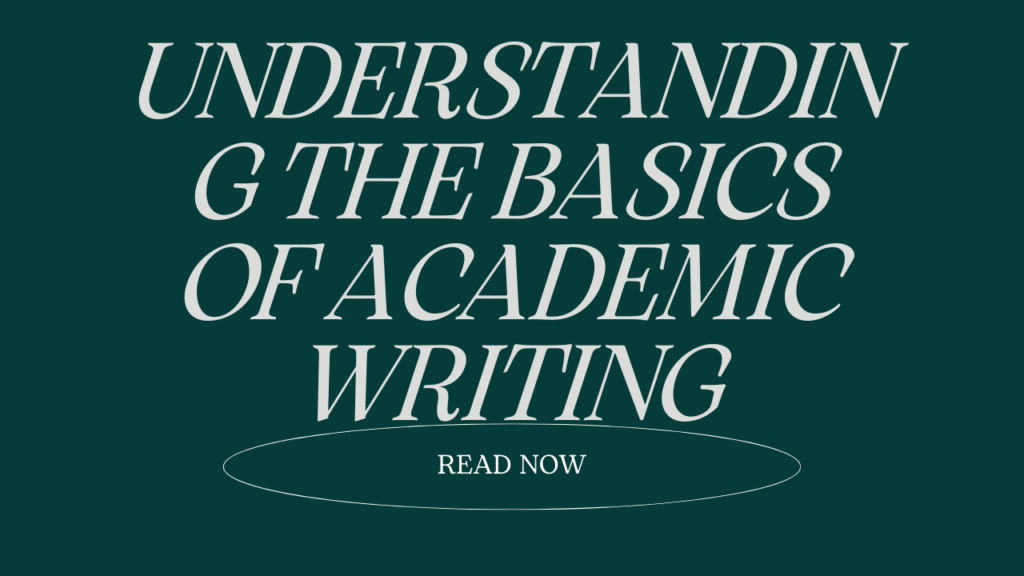Analytical writing is known for its objectivity. It is based on facts, reasoning, and logic. Fundamentally, it refers to a perspective grounded on research, evidence, and formal analysis. Purposefully, it is written in an unbiased and neutral tone. The researcher aims to provide clear, concise, and relevant information. Academic writing basics belong to discipline and interdisciplinary fields. It is more theoretical than practical. The motive of “scholarly writing” is to uphold depth and knowledge. Academic writing takes various forms, such as essays, scientific reports, articles, statistical records, book reviews, and summaries.
Characteristics Of Academic Writing
To understand academic writing basics, it is necessary to understand the main elements. Keep in mind the 4Cs rule. The writing should be:
Conventional
Understanding the academic writing basics is essential for academic success. The first important thing is to adopt a formal tone, as “academics” represent discipline.
Maintain a Formal Tone
The most crucial thing is to avoid using casual phrases and verbs. For instance, colloquialisms, anecdotes, metaphors, contractions, first-person pronouns, demonstrative pronouns, and informal slang.
Rigor
Educators and students seek evidence-based information. Therefore, it provides realistic and intellectual arguments over stories. The discipline-specific writing increases clarity and credibility. To be conventional you must maintain a formal tone and rigourousness.
Cognizant
To cultivate trust, showing understanding and having knowledge is essential. Hence, providing evidence is a crucial aspect of academic writing. Further information is a significant part of academic writing basics.
Citation
The writing must be based on proofs and citations. This might include bibliographies, reference lists, endnotes, footnotes, and in-text citations. This conveys to the reader the writer’s profound knowledge of a particular subject.
Evidence
The evidence comes from rigorous research, statistical data, literature reviews, historical context, scientific reports, and case studies as per the certain niche. Also, research uses visual aids like graphs and tables to demonstrate the results. To support rigorous research, you must add citations and practical evidence.
Also read: Can content writing make you rich?
Comprehensible
The analytical report must be clear and easy to understand. Whereas, clarification helps to avoid ambiguity.
Clarity
Avoid using hard language. The clear and concise language establishes easier understanding. A writer should write in detail at an accurate length but in a simple and to-the-point manner.
Verification
It supports verifying complex information in depth by explaining and defining key terms and concepts. It must convey “ It is what it is”, the real, raw and unfiltered. The research should be brief and clear and come from significant and rigorous research and reasoning
Complete
The most common element that falls under “academic writing basics” is completeness. Academic writing needs to follow proper structure for SEO as well as the reader’s understanding. The cohesiveness in writing increases the accuracy of information.
Structure
Academic writing must be supported with clear and compact information. The material needs to support well-structured data with proofs and logical reasoning. It must follow an understandable introduction, body of paragraphs and concise conclusion.
Accuracy
To ensure accuracy and lack of errors, proofread and revise the information again. Analytical writing does not support grammar, spelling, comprehension and language errors. Furthermore, avoiding such mistakes maintains the completeness of the researched information. To make content perfect, you must follow proper structure and factuality.
Essential Stages for Academic Writers
This section outlines the three-stage process that writers must follow to produce strong academic writing basics. Information, Clarification, and Transmission.
Stage One: Information
The researchers gather the information, observe, and analyze it. However, critical reasoning and theoretical evidence support the writer creating a first-stage conclusion for their understanding. It develops the surface level or basics of a specific purpose of writing.
Stage Two: Clarification
At this stage, the writer solves the doubt. Practice the responses. This is the point at which a writer must consider all of the doubts that are consistent with their topic. Problem-solving and decision-making skills need to be strong. Clarification is necessary during the process of doubt in order to achieve a higher degree of precision, thoroughness, and depth.
Stage Three: Transmission
This stage consists of conclusion, completeness and cohesiveness of information. This is the stage of delivery or presentation of research. Conciseness and clarity are crucial for information transmission. Furthermore, deep knowledge that is devoid of ambiguity is necessary. The final stage includes skilful articulation of their understanding with adequate perfection in their information.
Mastering Academic Writing Basics: Understanding Your Audience for Effective Communication.
Effective objective writing hinges on a deep understanding of its readership. The audience comes from different levels and fields. Basically, from new learners to highly experienced academics. To ensure your writing resonates, moderation and audience awareness are crucial components of academic writing basics. Follow these:
- Understand your target audience. Observe their pain points, insights and interests.
- Prioritise conveying complex ideas into understandable segments.
- Breaking down difficult subjects into smaller ones can help novices to grasp information easily.
- Use of brief and readable sections let readers interpret the content.
- Analysts must use memorable key terms and phrases to help them remember information.
- The well-structured information can improve the stickiness of the message. It improves the retention power of the reader.
- Add value to the information.
- Use their feedback and review them to improve. This habit builds trust and a loyal community.
Conclusion
Maintain the articulation of the subject. Draw logical and evidence-based conclusions rather than biased opinions. Facts need to be unchanging and impersonal regardless of the researcher’s perspective. Academic writing basics does not encompass only memorization. Instead, it needs to be “meaning-making.”It is about analysing the information, engaging with the data critically, synthesizing different ideas, and constructing your interpretation and understanding.
Follow Wabbithire for more!




